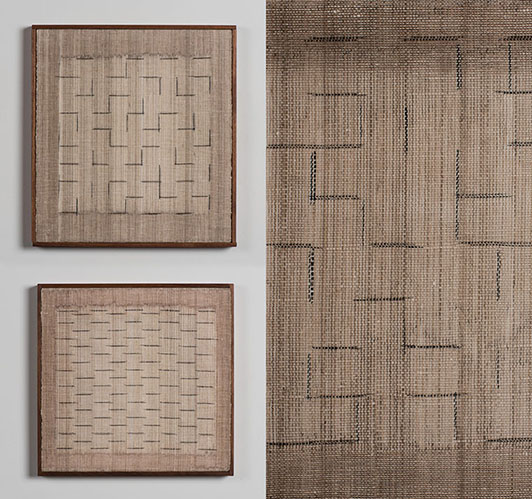A Line Can Go Anywhere, currently on display at the James Cohan Gallery in New York, studies the use of fiber as the main material used by seven Bay Area artists. The show examines artists ability to use linear pliable elements such as yarn, thread, monofilament, and rope.
A Line Can Go Anywhere works to show viewers all the ways in which fiber is utilized in art. The term “fiber” encompasses both the use of pliable material and technique needed to manipulate the materials to construct art works. “Crisscrossing generations, nationalities, processes, and approaches, the works speak to the cultural forces and art discourses that have contributed to a rich, and often overlooked, legacy of art making,” explains Jeffrey Waldon “from the initial efflorescence of the international fiber revolution of the 1960s to fiber’s recent reclamation by contemporary artists who, in an expanded field of art, create fiber-based work with a kind of ‘post-fiber’ awareness.”
The show features works from Trude Guermonprez and browngrotta arts’ artist Ed Rossbach, two influential artists whose works served as primers for the making of art in Northern California. The pair “contributed to the categorical transformation of art and craft,” notes the Gallery. In addition to Rossbach and Guermonprez, A Line Can Go Anywhere will feature work by Josh Faught, Terri Friedman, Alexandra Jacopetti Hart, Ruth Laskey, and browngrotta arts’ artist Kay Sekimachi.

Top: Homage to Paul Klee, Kay Sekimachi, linen, painted warp & weft with dye, permanent marker, modified plain weave, 13.25” x 12”, 2013
Bottom: Lines, Kay Sekimachi, linen, painted warp & weft with dye, permanent marker, modified plain weave, 11.5″ x 11.75″, 2011
With a sincere devotion to textile traditions and worldwide culture, Ed Rossbach’s work referenced everything from ancient textile fragments to pop-culture icons such as Mickey Mouse. Rossbach experimented with atypical materials to create an anti-form intimate body of work. Despite being a prolific maker, write and professor at the University of California between 1950 and 1979, Rossbach, by his own choice, rarely exhibited or sold his work. Shortly before his death in 2002 he provided a large number of his remaining works of fiber, paintings, and drawings to Tom Grotta to photograph and exhibit. Most of Rossbach’s remaining works continue to be available through browngrotta arts. Kay Sekimachi began working in fiber in 1960s, just as the international fiber movement began. For a number of years, according to the Gallery, Sekimachi’s work was “charged by Guermonprez’s pedagogical emphasis on both free experimentation and the rational logic of weaving.” Sekimachi’s early double weavings showcased her ability to harmonize the opposite relationships of density and translucency, complexity and simplicity, technique and free expression.
A Line Can Go Anywhere was curated by Jenelle Porter, an independent curator in Los Angeles. From 2011 to 2015 she was the Mannion Family Senior Curator at the Insitute of Contemporary Art/Boston where she organized the acclaimed Fiber Sculpture 1960-present. A Line Can Go Anywhere is on show at the James Cohan Gallery in New York until October 14th. For more information about the show click HERE.


